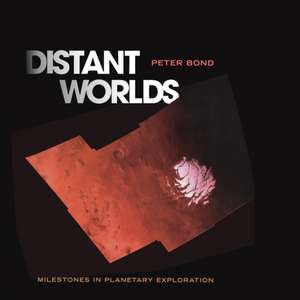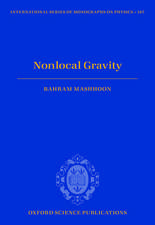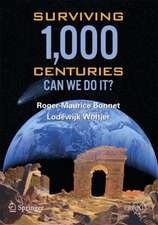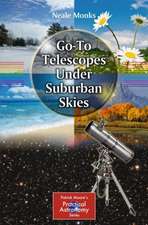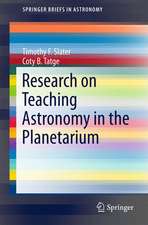Distant Worlds: Milestones in Planetary Exploration
Autor Peter Bonden Limba Engleză Paperback – 22 oct 2016
| Toate formatele și edițiile | Preț | Express |
|---|---|---|
| Paperback (1) | 228.52 lei 3-5 săpt. | |
| Springer – 22 oct 2016 | 228.52 lei 3-5 săpt. | |
| Hardback (1) | 243.02 lei 3-5 săpt. | |
| Springer – 28 feb 2007 | 243.02 lei 3-5 săpt. |
Preț: 228.52 lei
Nou
Puncte Express: 343
Preț estimativ în valută:
43.73€ • 47.49$ • 36.74£
43.73€ • 47.49$ • 36.74£
Carte disponibilă
Livrare economică 01-15 aprilie
Preluare comenzi: 021 569.72.76
Specificații
ISBN-13: 9781493938339
ISBN-10: 1493938339
Pagini: 340
Ilustrații: X, 324 p. 241 illus. in color.
Dimensiuni: 203 x 203 x 18 mm
Greutate: 0.54 kg
Ediția:2007
Editura: Springer
Colecția Copernicus
Locul publicării:New York, NY, United States
ISBN-10: 1493938339
Pagini: 340
Ilustrații: X, 324 p. 241 illus. in color.
Dimensiuni: 203 x 203 x 18 mm
Greutate: 0.54 kg
Ediția:2007
Editura: Springer
Colecția Copernicus
Locul publicării:New York, NY, United States
Cuprins
Discovering Distant Worlds.- Mercury: The Iron Planet.- Venus: The Runaway Greenhouse.- The Moon: Queen of the night.- Mars: The red planet.- Asteroids: Vermin of the skies.- Jupiter: King of the planets.- Saturn: Lightweight lord of the rings.- Uranus: The toppled giant.- Neptune: The last giant.- Pluto: King of the Kuiper Belt.- Comets: Cosmic icebergs.
Recenzii
From the reviews:
"The author describes the achievements of the astronomers, space scientists, and engineers … . This compelling account of the Space Age includes dramatic accounts of the daring, resourcefulness, and ferocious competitive zeal of renowned as well as almost-forgotten space pioneers; clear explanations of the precursors to modern astronomy … 100 informative photographs, maps, simulated scenarios, and technical illustrations, many in full color; appendices on the physical properties of our solar system; as well as a comprehensive list of 50 years of solar system missions." (The Lunar and Planetary Information Bulletin, May, 2007)
"Peter Bond, a professional Science writer with close ties to the Royal Astronomical Society, provides a comprehensive and well-illustrated summary of planetary exploration … . The account is both accurate and up-to date. … This is an ideal introduction to the current state of Solar System science, whether you’re a science student, amateur astronomer or interested layperson." (Fred Taylor, BBC Sky at Night, August, 2007)
"In an overview of ‘where we stand today’, Peter Bond describes the remarkable achievements of the astronomers, space scientists, and engineers who have made it possible to unravel the mysteries of the distant worlds that make up our Solar System. … More than 250 illustrations, including photographs, maps, artists’ impressions, and explanatory diagrams-many of them in full color. … Bond shows how the great enterprise of planetary exploration can justifiably be regarded as one of the great triumphs of human civilization." (www.eurekalert.org, May, 2007)
"The author writes with a fresh, fast pace that captures the excitement of exploring each planet in those heady, early days of space exploration … . The text is fully up-to-date, including results from the Huygens probe to Saturn’s moon Titan, and the discovery of new moons orbiting Pluto. …plenty of detail on the historical discoveries and science of each planet add to the value of this book. Packed with images … this is a visual as well as textual masterpiece." (John Rowlands, Astronomy Now, July, 2007)
"Peter Bond explores how ground-based observers and robotic sentinels have alleviated our astronomical ignorance about the solar systern. … Bond provides an engaging chronology of each world and its satellites, as well as separate chapters for asteroids and comets. … Appendices list all planetary missions grouped by target, characteristics of the planets and satellites, lunar and planetary ‘firsts’, and a wealth of printed and online references." (Stuart J. Goldman, Sky and Telescope, October, 2007)
"As an introduction and overview to our current understanding of the solar system, Distant Worlds is a serviceable book. Bond provides a readable, accurate review of our knowledge of each planet, as well as comets and asteroids. … Distant Worlds is a good review of our (more-or-less) current understanding of the solar system, particularly for those people not terribly familiar with anything more than the basics."(Jeff Foust, The Space Review, June, 2007)
"Bond writes in a clear, concise fashion that would be interesting reading for an undergraduate. … The index is well done. Summing Up: … General readers; lower division undergraduates." (J. R. Kraus, CHOICE, Vol. 45 (2), October, 2007)
"The author describes the achievements of the astronomers, space scientists, and engineers … . This compelling account of the Space Age includes dramatic accounts of the daring, resourcefulness, and ferocious competitive zeal of renowned as well as almost-forgotten space pioneers; clear explanations of the precursors to modern astronomy … 100 informative photographs, maps, simulated scenarios, and technical illustrations, many in full color; appendices on the physical properties of our solar system; as well as a comprehensive list of 50 years of solar system missions." (The Lunar and Planetary Information Bulletin, May, 2007)
"Peter Bond, a professional Science writer with close ties to the Royal Astronomical Society, provides a comprehensive and well-illustrated summary of planetary exploration … . The account is both accurate and up-to date. … This is an ideal introduction to the current state of Solar System science, whether you’re a science student, amateur astronomer or interested layperson." (Fred Taylor, BBC Sky at Night, August, 2007)
"In an overview of ‘where we stand today’, Peter Bond describes the remarkable achievements of the astronomers, space scientists, and engineers who have made it possible to unravel the mysteries of the distant worlds that make up our Solar System. … More than 250 illustrations, including photographs, maps, artists’ impressions, and explanatory diagrams-many of them in full color. … Bond shows how the great enterprise of planetary exploration can justifiably be regarded as one of the great triumphs of human civilization." (www.eurekalert.org, May, 2007)
"The author writes with a fresh, fast pace that captures the excitement of exploring each planet in those heady, early days of space exploration … . The text is fully up-to-date, including results from the Huygens probe to Saturn’s moon Titan, and the discovery of new moons orbiting Pluto. …plenty of detail on the historical discoveries and science of each planet add to the value of this book. Packed with images … this is a visual as well as textual masterpiece." (John Rowlands, Astronomy Now, July, 2007)
"Peter Bond explores how ground-based observers and robotic sentinels have alleviated our astronomical ignorance about the solar systern. … Bond provides an engaging chronology of each world and its satellites, as well as separate chapters for asteroids and comets. … Appendices list all planetary missions grouped by target, characteristics of the planets and satellites, lunar and planetary ‘firsts’, and a wealth of printed and online references." (Stuart J. Goldman, Sky and Telescope, October, 2007)
"As an introduction and overview to our current understanding of the solar system, Distant Worlds is a serviceable book. Bond provides a readable, accurate review of our knowledge of each planet, as well as comets and asteroids. … Distant Worlds is a good review of our (more-or-less) current understanding of the solar system, particularly for those people not terribly familiar with anything more than the basics."(Jeff Foust, The Space Review, June, 2007)
"Bond writes in a clear, concise fashion that would be interesting reading for an undergraduate. … The index is well done. Summing Up: … General readers; lower division undergraduates." (J. R. Kraus, CHOICE, Vol. 45 (2), October, 2007)
Notă biografică
Peter Bond is a Press Officer for the Royal Astronomical Society and Consultant for the European Space Agency.
Textul de pe ultima copertă
Peter Bond provides an overview of key, unmanned missions, chapter by chapter, to planets in the twentieth century. He tells the story of the mission planners and engineers who, working mostly in the background, made these unprecedented achievements in scientific exploration possible. Bond’s perspective provides a much-needed overview, but it also details the very human feelings that animated the intense rivalries between the Soviet Union and the United States, and most recently the difficulties that arose in collaborations between NASA and ESA on the Rosetta and Halley's Comet missions.
